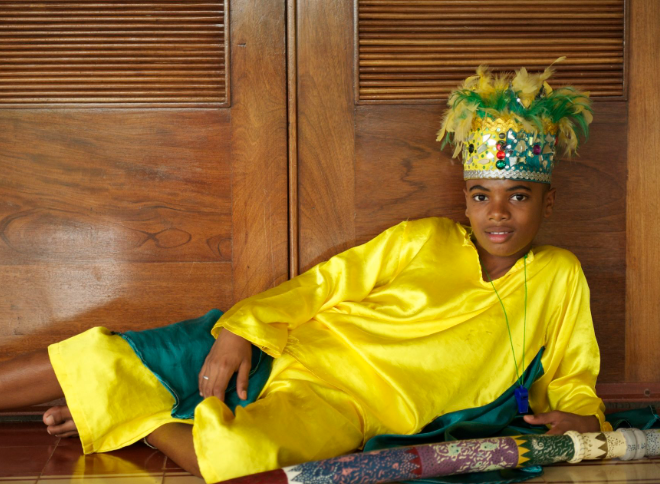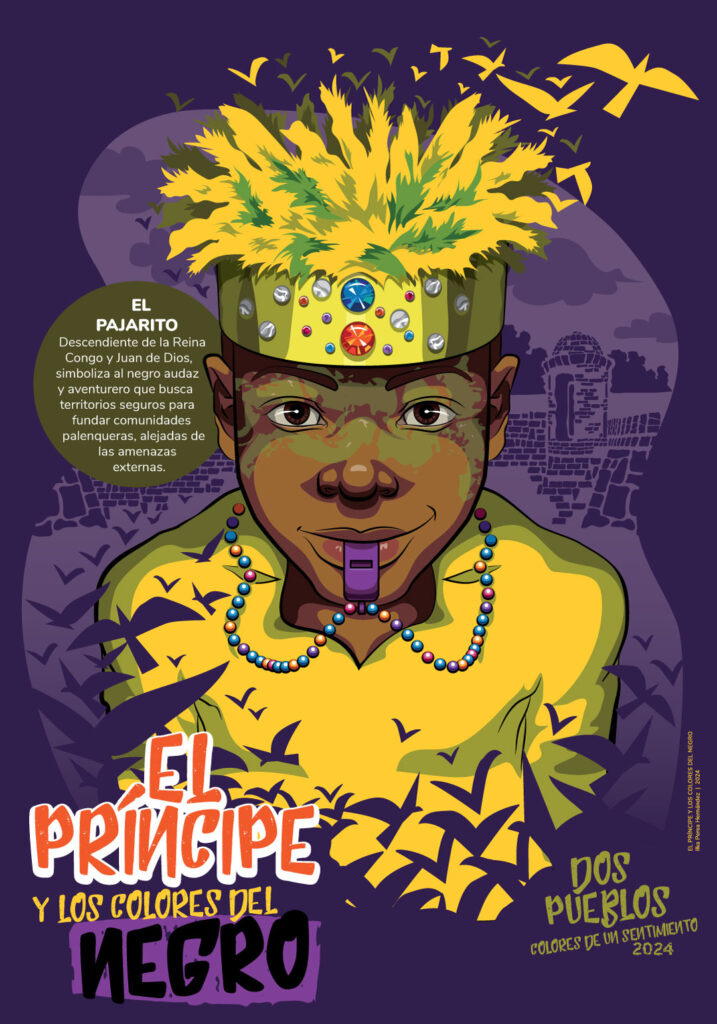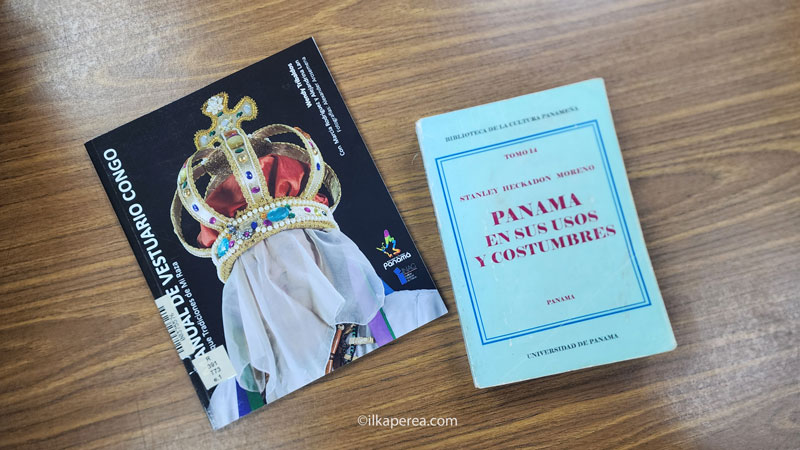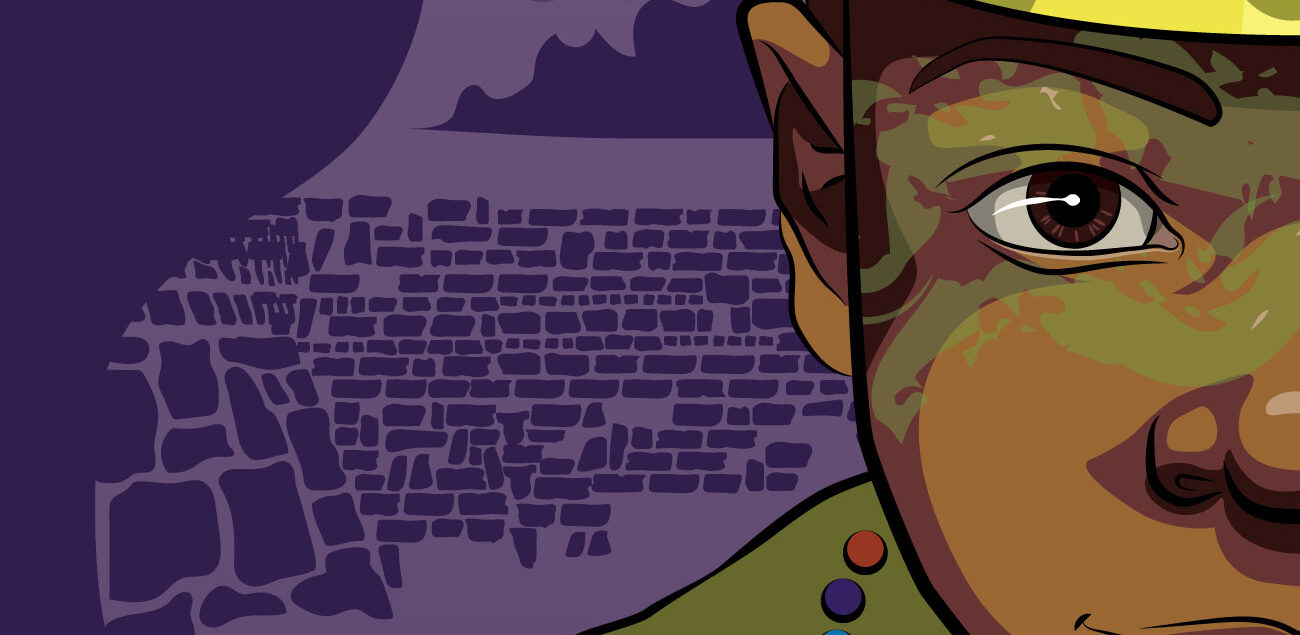The Poster about El Pajarito
Last Updated on November 11, 2024 by Ilka Perea Hernández
As part of the celebration of Black Ethnicity Month in
Panama, I designed a poster titled “El Príncipe y los Colores del Negro” (The Prince and the Colors of the Black), featuring a graphic representation of the character El Pajarito (the Little Bird) from the Congo culture of Panama.
In this post, I will briefly explain why I chose this character as the central theme of the poster, starting with some historical and cultural context to better understand his significance. Finally, I’ll share a few thoughts on the subject by way of conclusion. I invite you to check out the comments section and share your opinions or experiences related to this topic.
Tabla de Contenido
- The Congos of Panama
- What is Congo Culture?
- Historical Context
- Influence on Panama’s Culture
- Characters in Congo Culture
- El Pajarito
- Who is El Pajarito?
- Poster Design
- El Pajarito as a Central Theme
- Some Insights
- Fly, Flye Little Bird (El Pajarito)… ¡to the Mexico Biennial!
- There is more than one Pajarito in this story…
- Any Thoughts?
The Congos of Panama
What is Congo Culture?
The Congo culture in Panama traces back to the traditions of African slaves who arrived during the colonial era, particularly in the Panamanian Caribbean, mainly in the province of Colon. These slaves, from various African ethnic groups, created a culture of resistance that helped them preserve their identity and beliefs despite the oppression they faced.
Historical Context
During the colonial period (16th-19th centuries), enslaved Africans were brought to work in plantations, mines, and other forced labor. In response to the brutality of slavery, Afro-descendant communities developed a syncretic culture that combined African, indigenous, and European elements. In particular, the Maroons, slaves escaping from the plantations, played an important role in the resistance against colonization, and many settled in free communities.
In this context, the fairs of Portobelo and the Ruta de la Plata were key economic and social factors. Portobelo, a strategic city on the Caribbean coast, became one of the most important ports for colonial trade. Through the Portobelo fairs, European, Asian, and American products were exchanged, including the riches from Peru that were transported along the Silver Route. This route connected the mines of Potosí (in present-day Bolivia) with Panama, where silver and other goods were transported overland for shipment to Europe.
This theme inspired me to create another poster. I invite you to check out the process in my portfolio on Behance.
The flow of wealth and the constant movement of merchandise through these routes made Portobelo a hub of commerce, but also a scenario for the intensification of slavery. African slaves, taken under inhumane conditions along this route, were used to transport merchandise and work in port and maintenance tasks. However, many of these slaves escaped and formed Maroon communities in the nearby mountainous areas.
The Maroons, upon escaping, settled in inaccessible areas of the jungle, from where they attacked the caravans of the Ruta de la Plata and other colonial expeditions, appropriating resources and weakening Spanish control in the region. The Congo festivals and rituals that emerged in these communities reflected both their resistance and their cultural autonomy, celebrating freedom and mocking the colonial structures that sought to oppress them.
Influence on Panama’s Culture
Congo culture is still a vibrant part of Afro-descendant identity in Panama today. It’s celebrated with festivals like the Festival of Diablos and Congos, showcasing traditional dances, songs, and costumes. Beyond its cultural significance, Congo heritage has also influenced Panama’s music, food, and artistic expressions. Through its rituals and art, Congo culture has helped preserve African roots and has strengthened the sense of identity within the country’s Afro-descendant communities.
Characters in Congo Culture
The main characters of Panama’s Congo culture each have a specific role within the dances and rituals:
- The Congo King and Queen (La Reina y el Rey Congo): They are the most important and symbolic figures, representing authority and leadership within the Congo community. They are in charge of guiding their people and symbolize resistance against colonial oppression.
- The Little Bird (El Pajarito): An agile and cunning character, he is a messenger between the earthly and spiritual worlds. He is known for his ability to move lightly and evade danger, which makes him a symbol of freedom and resistance.
- Devils (Los Diablos): They represent the forces of evil, slavery, and oppression. They are usually antagonistic figures that try to subdue the Congo. The devils are symbolically defeated in the dances, representing the victory of freedom over slavery.
These characters, and others, are part of a symbolic narrative celebrating resistance, freedom, and cultural survival. Each has a role within the Congo festivities and rituals, and together, they reflect the themes of struggle and liberation that are fundamental to Afro-descendant culture in Panama.
Even the ritual and festive expressions of the Congo culture were inscribed in 2018 on UNESCO’s Representative List of the Intangible Cultural Heritage of Humanity.
El Pajarito

Who is El Pajarito?
The figure of El Pajarito holds deep symbolism in Congo rituals and dances, rooted in the resistance of enslaved Africans brought to Panama during colonial times. These rituals blend African cultural elements, indigenous influences, and Christian symbolism.
In the Congo tradition, El Pajarito is seen as a messenger who bridges the gap between humans and spirits, known for his ability to move between the earthly and spiritual realms. During Congo dances and rituals, he’s often portrayed as an agile, lively, and clever character who uses his songs and movements to deliver important messages or guide other characters in the Congo dance narrative.
His role can vary depending on local interpretations, but generally, he represents freedom, cleverness, and a connection with nature—values that carry deep significance in the context of cultural and spiritual resistance within the Congo community. The dance and story of El Pajarito also evoke liberation from oppression, as Afro-descendant communities in Panama used these cultural expressions to subvert colonial control and celebrate their identity.
Poster Design

El Pajarito as a Central Theme
As I explained in the post El Pajarito en la Bienal de México, I was invited by Ivo Baldovino of Panama Poster Group to participate in a group poster exhibition to celebrate Black Ethnicity Month in Panama. My initial idea was the graphic representation of the Congo Queen. But the more I researched about her, the more I was won over by El Pajarito. 😍
I realized that El Pajarito also holds a deeply personal meaning. He reflects something we all carry within us: that strength that pushes us to keep going, even when we feel uncertain or scared… or full of fear.
Sometimes it’s hard to take that first step, but that same ‘inner strength,’ like El Pajarito in his dance, drives us to face our fears, overcome obstacles, and push our limits.
That’s why I chose El Pajarito as the central theme of my poster. I wanted to express the idea that, like El Pajarito, we can all find our freedom if we listen to that inner voice that reminds us not to let fear clip our wings, and to fly as high and as far as our dreams take us.⭐
Some Insights
Panamanian culture is rich with symbols that, as designers, we can explore, research, and draw inspiration from to incorporate into our visual language, creating unique and authentic pieces that reflect Panamanian identity.

I have chosen the Afro-colonial culture because I am from the city of Colon, on the Panamanian Caribbean coast and I spent my summers as a child in Portobelo (besitos a mis tíos y primos, sobre todo a tía Evelina y mi primo Octavito 💜💕💜 ). I have ethnic and emotional connections with that culture. But, as a designer, you can choose the local culture you like or identify with the most and start researching it. I assure you that you will find elements and symbols that were there that you overlooked.
Fly, Flye Little Bird (El Pajarito)… ¡to the Mexico Biennial!
If you read my post (only in Spanish) El Pajarito en la Bienal de México, you already know that this poster about El Pajarito was selected as one of the finalists in the Bienal Internacional de Cartel en México (BICM).
If you read the whole post, you also know the important role my friend Ivo Baldovinos played in my participation in this important biennial. As I explained, El Pajarito had a personal meaning but my experience with Ivo forced me to make a retrospective and rethink the meaning of El Pajarito.
There is more than one Pajarito in this story…
While designing the poster, I always thought of the character as an inner voice that motivates and strengthens us. But what happens when, instead of listening to that inner voice, we hear “the impostor”? Impostor Syndrome is something many creatives struggle with.
When I hesitated to send the poster and my friend Ivo insisted, I submit it, he became that voice of encouragement. It made me realize that El Pajarito isn’t always about inner strength. Sometimes, it’s those everyday heroes in our lives who push us to pursue our dreams or comfort us during tough times: a mom, a sibling, a mentor, a teacher, or a good friend.
In the same way, we can be someone else’s El Pajarito. You don’t need to wear yellow and run around blowing a whistle. All it takes is empathy, support, and recognizing our shared humanity. Be that person for someone else when they’re facing something you’ve been through.
Any Thoughts?
In the comments section, tell me if you have already participated in biennials or any other design contest. Do you like poster design? Did you already know about the Congo culture of Panama and the meaning of El Pajarito?

Share
Spread the love… and this post!
If you liked it, share this post on your social networks. Smart designers share good things with others.

